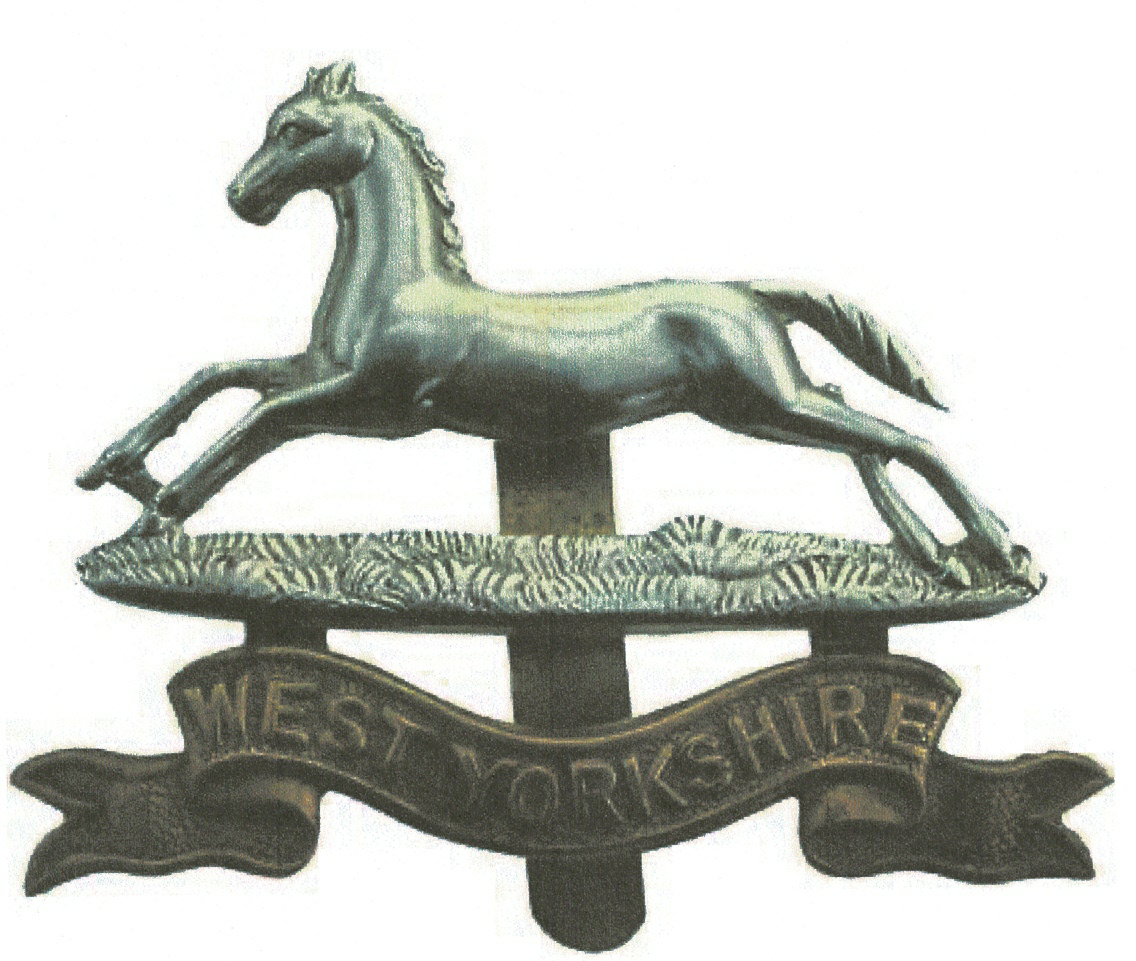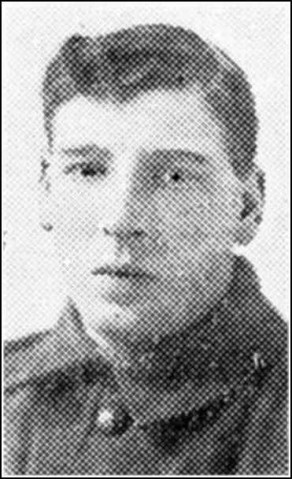
6th (UK) Division
Identity Patch
57429 Private Thomas Edward Inman
[KIA]
1st Battalion
Prince of Wales' Own
(West Yorkshire Regiment)
18th Brigade
6th Division
1914-1918
This file last updated 5 August, 2021 17:42

Badge
Prince of Wales'
West Yorkshire Regiment
Military information in this record is from Craven's Part In The Great War,
The Long, Long Trail, British National Archives
and Wyrall, Everard, "The West Yorkshire Regiment:In the War 1914-1918" Vols 1 & 2,London, John Lane The Bodley Head Limited
and family information from Michael William Downs & Clive Mitchell-Taylor, supplemented with inspired guesswork.
Introduction

Thomas Inman
Thomas Edward Inman, 1891 - 17 Sep 1918, was born in SKIPTON, YORKSHIRE, the son of John William Inman and Mary Jane, née Thistlethwaite. John was born at EMBSAY and Mary at INGLETON, YORKSHIRE.
Thomas is employed as an "overlooker" (superintendant or overseer) at Belle Vue Mills in SKIPTON, he marries Edith Downes in 1915. Living in Keighley Road, SKIPTON, they have one child and he adopts the child of his wife.
Enlisting in the Regular Army in June 1917, he is appointed as a reinforcement to the 1st Battalion of the Prince of Wales' Own (West Yorkshire Regiment) which has been in FRANCE since 10 Sep 1914. He joins the unit in November 1917.
The obituaries published in "Craven's Part in the Great War" (Craven is the name of the district) contain tributes from his brothers, sisters and nieces, but there is no mention of his wife. Should she have already been widowed once by the war, and this is plausible considering the fact that she had two young child, her absence is understandable. Whatever the story, it will for the time being, remain untold.
Thomas' death on 17 Sep 1918 coincides with the 6th Division's preparation for an attack on ST QUENTIN which began the next day. His Medal Roll card (see below) is annotated "disembodied", which means that there is no body and therefore no grave. His death had to have been caused by an explosion, most probably from an artillery strike. The British would be using artillery to keep the Germans occupied so that they could probe the (barbed) wire for weak spots and assess their position and defences prior to the attack, while the Germans retaliated in kind. Brother-in-law Stephen Downes' shrapnel wounds were acquired in similar circumstances.
His details are commemorated on the VIS_EN_ARTOIS MEMORIAL,PANEL 4, FRANCE. There is no image of the entry, but the CWGC is in the process of adding images to points of commemoration. See his:
See his:
-
Medal Roll Card (bottom right of the images on this sheet)
He is also honoured on the impressive SKIPTON WAR MEMORIAL which has some 371 names of WW1 war dead from SKIPTON and was unveiled on 8 Apr 1922. The Order of Oddfellows also has a memorial described below.
Relatives Who Served in WW1
Relatives who Served
Brother-in-law Thomas Downes served with the 2nd/6th Duke of Wellington's West Riding Regiment and was WIA, DOW
Brother-in-law Joseph Downes served with the 2nd/5th Battalion, Prince of Wales' Own, West Yorkshire Regiment.
Brother-in-law Stephen Downes served in the AIF and married Walter's sister Rosa Houseman in Stockton NSW in 1919. He was WIA in 1917 and repatriated to Australia.
Brother-in-law Walter Houseman served with the 1st/8th Battalion Durham Light Infantry and was KIA.
Brother-in-law George Houseman served with the 1st/5th Battalion Duke of Wales' Own, West Yorkshire Regiment and was WIA.
Brother-in-law Joseph also serves in WW1 in the British Army and the Medal Roll Card (top right of the six cards on the sheet) which I believe is his, records his Corps as "W York R T Bn" with the Regimental Number "TR5/77053". "TR5" is an abbreviation of "Training Regiment 5th Battalion". The UK Territorial Army is the equivalent of the Australian Citizens Military Forces (CMF) and the later Australian Army Active Reserve (AAAR).
Brother-in-law Stephen Downes having emigrated to AUSTRALIA in 1911 serves with the 19th Infantry Battalion AIF on GALLIPOLI and in FRANCE with the 8th Field Engineer Company AIF until he is severely wounded on 9 Feb 1917.
He recovers in ENGLAND and takes furlough in YORKSHIRE where he may or may not have caught up with his siblings. He lived with his widowed aunt Mary Ann Dobby while a child and is likely to have returned there. He certainly strikes a chord with one local lass. He returns to AUSTRALIA where he marries Rosa Houseman of PADSIDE GREEN on 6 Sep 1919, the day after she disembarks in AUSTRALIA having sailed from ENGLAND with other wartime prospective brides.
This record prepared by Clive Mitchell-Taylor based upon records obtained from Craven's Part In The Great War. Craven is the name of the Distict.
See below for newspaper reports concerning the death of Thomas Ingman.
The 1st Battalion West Yorkshire Regiment in France from Nov 1917
The West Yorkshire Regiment: In the War 1914-198, Volume 2, Everard Wyrall, John Lanethe Bodley Head Limited, Vigo St, London

Rifle, Small Magazine Lee-Enfield .303in, Mark III with sword bayonet
Battle of Cambrai
19-20 Nov 1917 sees the 1st Battalion West Yorkshire take its place as a part of the 6th Division on the left of the line in the first phase of the attack of the Battle of Cambrai - a proud symbol of what later became the Armoured Corps, on the Hindenburg front, the battalion forming the advance guard of the 18th Brigade and assembling southwest of Beaucamp village.
The attack commenced at 6:20am but the Brigade was not to move forward until about 08:00. On reaching
the
The 1st Battalion remained in place until 24 Nov 1917 when it moved back into Ribecourt and on the 26th moved forward (less A Company) to relieve the 2nd Coldstream Guards in support of the sunken road south-west of Cantaing.
The Germans counter-attacked on 30 Nov 1917 and of the 1st Battalion only three junior officers
and 40 men of the Regimental Transport fought a gallant action against the Germans resulting in the award of
a
Newspaper Reports - Craven Herald and Wensleydale Standard
11 Oct 1918
Private T.E. Inman Official news, was received yesterday that Private T. E. Inman, West Yorkshire Regiment, son of Mr. and Mrs. J. W. Inman, 14 Albert Street, Skipton, was killed in action in France on September 17th. Formerly an overlooker at Belle Vue Mills, Skipton, and 27 years of age, Private Inman joined up in June last year and went to the Front five months later. He leaves a wife, one child and an adopted child living at 15 Keighley Road, Skipton. We will give a photograph next week.
11 October 1918,
Private T.E. Inman, Skipton
The photograph [shown above] is that of Private T. E. Inman, West Yorkshire Regiment, of Skipton, whose death in action on September 17th we reported last week. A touching letter of sympathy has been received by his wife from the Chaplain, who conducted the funeral service.
19 September 1918,
INMAN – In ever loving memory of our dear son and brother, Pte. Thomas Edward Inman (Tom), 1st West Yorks., killed in action 17th Sept., 1918.
He left behind some aching hearts
That loved him very dear,
Hearts that never can forget,
For his memory is written here.
From his loving Mother, Father, Sisters and Brother.
INMAN – In ever loving memory of our dear son and brother, Pte. Thomas Edward Inman (Tom), 1st West Yorks., killed in action 17th Sept., 1918.
Upright and just in all his ways,
Faithful and true to the end of his days,
Forgotten by some, to the world he may be,
But true to our memory he never will be.
‘Tis sad but true, we don’t know why,
The best are the first that are called to die.
From his loving Sisters Mabel and Maggie, Brother Ernest, and Nieces Violet and Margaret.
INMAN – In ever loving memory of our dear brother, Pte. Thomas Edward Inman (Tom), 1st West Yorks., killed in action 17th Sept., 1918.
Fondly we loved him, he is dear to us still:
But in grief we must bend to God’s holy will;
Our sorrow is great, our loss hard to bear,
But the angels, dear brother, will guard you with care.
From his loving Sisters Mary Ann and Jane, and Brothers-in-law Jack and John.
17 September 1918,
INMAN – In loving memory of our dear son and brother, Pte. T. E. Inman, killed in action Sept. 17th, 1918.
Fresh in our hearts your memory clings,
Yet still our grief is sore;
But each passing year will nearer bring
The day we meet once more.
From his loving Mother, Father, Sisters and Brothers.
INMAN – In loving memory of our dear brother, Pte. T. E. Inman, killed in action Sept. 17th, 1918.
The midnight star shines on the grave
Of the one we loved but could not save.
From his loving Sisters and Brothers, Jane and Jack, and Mary Ann and Jack.
INMAN – In loving memory of our dear brother, Pte. T. E. Inman, killed in action Sept. 17th, 1918.
‘Tis only those who have loved and lost
Who now realise war’s bitter cost.
From his loving Sisters and Brother, Maggie, Mabel, Ernest; and nieces Violet and Margaret.
23 February 1923
ODDFELLOWS' WAR MEMORIAL
UNVEILING CEREMONY AT A SKIPTON LODGE
OVER 200 WHO SERVED
There was a large attendance of local members of the Independent Order of Oddfellows at the Friendly Societies’ Hall, Skipton, on Saturday afternoon, on the occasion of the unveiling of a war memorial to the members of the Loyal Traveller’s Friend Lodge, I.O.O.F, M.U., who fell in the war.
The Memorial takes the form of a beautifully designed scroll within an oak frame with a glass front, the work of Mr. H. Spencer, junr., and it bears the inscription:–
LOYAL TRAVELLER’S FRIEND LODGE,
SKIPTON DISTRICT.
I.O.O.F. ROLL OF HONOUR M.U. OF
THOSE MEMBERS OF THIS LODGE
WHO FOUGHT FOR THEIR KING AND COUNTRY
TO UPHOLD THE SACRED CAUSES OF BROTHERHOOD
AND HUMANITY IN THE GREAT WAR, 1914–1918.
Below the inscription are the names of 173 members who served in the war, and of the 40 members who were killed. The names of the fallen occupy a central position on the scroll, and above them are the following words:–
IN MEMORIAM OF THOSE WHO MADE THE SUPREME SACRIFICE.
THEIR HEARTS ARE LIFTED UP, THEIR HEARTS THAT HAVE FOREKNOWN THE UTTER PRICE,
THEIR HEARTS BURN UPWARD AS A FLAME OF SPLENDOUR AND OF SACRIFICE
The names of the fallen are as follows:–
H. Armstrong, J.J. Brown, J. Barrett, Robt. Brown, W.W. Bell, A. Clayton,
W.H. Coles, T.C. Chew, Tom Downes, T.M. Drummond, Jos Emmott, Thos. Edmondson,
J. Easterby, F. Gallagher, J.W. Garwood, G.E. Godwin, S.J. Hargreaves,
M. Hargreaves, A. Hebden, J. Hebden, A. Hawkswell, T.E. Inman, M. Lund,
R.C. [R.G.] Metcalfe, Hbt. Maudsley, Hy. Maudsley, A.J. Pimnock [Pinnock],
H.Y. [Harry] Riley, T.W. Storey, J.H. Stewart, R. Spencer, J.W. Shuttleworth,
Wm. Tempest, Hbt. Thompson, Fred Thornton, J.W. Varley, John Ward,
J.A. Whittaker, J.W. Whittaker, and R.D. Whittaker.
The Unveiling Ceremony
The unveiling ceremony was presided over by Bro. Thos. Bellamy, and was performed by Bro. Amos Culpan, Prov. C.S., and a simple service included the singing of the hymns, ‘O God our help’ and Kipling’s Recessional, ‘God of our fathers,’ and the reading of a portion of Scripture, and the offering of a prayer by Bro. James Greenwood, of Bradford, and formerly of Skipton.
Bro. Bellamy observed that those members of the Lodge whom they were met to honour went into battle, suffered untold privations, and, in many cases, made the supreme sacrifice. They gave their lives in defence of their homes and their country. Further than that, they gave their lives for justice and freedom, and in order that we might live. It was the duty of Oddfellows, equally as much as other sections of the community, to do everything within their power to make the country better for that sacrifice. “In the time of our prosperity,” concluded Bro. Bellamy, “never let us forget those who served us in the time of our adversity.”
A Lesson of the War
Prior to unveiling the memorial, Bro. Culpan described the ceremony he had been asked to perform as one not unattended by sorrow. It was an occasion upon which one felt a desire to make their Order better for the sacrifice of its members, and to extend the true spirit of brotherhood. In nearly 4,000 of their Lodges they would find a roll of honour. Over 22,000 of their members made the supreme sacrifice, and thousands of others were ruined and shattered in health and without prospects for the future. Each and all of them ought to perform some daily service that would make the sacrifice of those men worth while. One result of the terrible ordeal of 1914 to 1918 was the creation of a better feeling between men, and a desire to break down the class barriers that formerly existed. That was one of the great lessons of the war.
Newspaper Reports - West Yorkshire Pioneer
11 October 1918
Another Skipton Soldier Killed
Official information was received yesterday morning from the infantry Record Office, York, that Pte. Thomas Edward Inman, West Yorkshire Regiment, husband of Mrs. Inman, 15, Keighley Road, Skipton, and son of Mr. and Mrs. J.W. Inman, 14, Albert Street, Skipton, was killed in action on Sept. 17th. Pte. Inman, who was 27 years of age, enlisted in June, 1917, and went out to France in November of the same year. He was formerly employed as an overlooker at Belle Vue Mills
Awards and Decorations
Private Thomas Inman is entitled to wear the British War Medal and Victory Medal, but not the 1914-15 Star. See his Medal Roll entry which is at the top right of the 6-card sheet from British Archives.
1914-15 Star
[Extract from Ribbons and Medals: Naval, Military, Air Force and Civil, Captain H. Taprell Dorling, DSO RN,
George Philip & Son, 33 Fleet Street, London EC4, 1940]

The decoration consists of a four-pointed star in bright bronze as shown, with the date 1914-15 on the central scroll. The reverse is plain, and is stamped with the name and unit of the recipient. The ribbon is red, white and blue, shaded and watered, worn with the red nearest the centre of the breast. It is atached to the medal through a ring.
It is similar in shape and description to the 1914 Star, to which few, if any, Australians were entitled.
The decoration, sanctioned in 1918, was issued "to all officers, warrant officers, non-commissioned officers and men of the British, Dominion, Colonial and Indian Forces, including civilian medical practitioners, nursing sisters, nurses and others eployed with military hospitals, who actually served on the establishment of a unit in a theatre of war as defined in Appendix 'A'. Individuals in possession of the 1914 Star will not be eligible for the award of this decoration."
Appendix 'A' included the Western, Eastern, Egyptian, African, Asiatic and Australasian Theatres of war, with commencement dates individual to countries and campaigns.
British War Medal 1914-20
[Extract from Ribbons and Medals: Naval, Military, Air Force and Civil, Captain H. Taprell Dorling, DSO RN,
George Philip & Son, 33 Fleet Street, London EC4, 1940]

This medal was approved by King George V in 1919 to record the bringing of the war to a successful conclusion and the arduous services rendered by His Majesty's Forces.
The medal, which is supended from its ribbon by means of a straight clasp, without swivel, bears on the obverse the effigy of His Majesty - exactly similar to that on a half-crown - with the legend 'Georgivus V : Omn : Rex et Ind : Imp'.
The reverse bears a design which represents St George on horseback, trampling underfoot the eagle shield of the central powers and a skull and crossbones, the emblems of death. Overhead is the risen sun of victory. The male figure, rather than a symbolical female one, was chosen because man had borne the brunt of the fighting. The figure was mounted on horseback as symbolical of man's mind controlling force (represented by the horse) of far greater strength than his own. The design is thus also symbolical of the mechanical and scientific appliances which helped so largely to win the war.
The ribbon has a orange watered centre with stripes of white and black at each side and with borders of royal blue. It is stated that the colours have no particular signification.
Victory Medal
[Extract from Ribbons and Medals: Naval, Military, Air Force and Civil, Captain H. Taprell Dorling, DSO RN,
George Philip & Son, 33 Fleet Street, London EC4, 1940]

This medal, of bronze, bears on the obverse a winged figure of Victory, full length in the middle of the medal and full face; the borders and the backgound plain, without either incription or date. On the reverse is an inscription. "The Great War for Civilization." and either the names of the different Allied and Associated Powers, or their coats of arms.
The rim is plain, and the medal hangs from a ring. The ribbon is red in the centre, with green and violet on either side shaded to form the colours of two rainbows.
It has also been approved that any officer or man who has been "mentioned in despatches" shall wear a small bronze oak leaf on the ribbon of this medal. Only one oak leaf is so worn, no matter how many "mentions" the wearer may have received.
The medal is designed to obviate the exchange of Allied Commemorative war medals, and is issued only to those who actually served on the establishment of a unit or ship in a theatre of war. [This is an important distinction, as those Australians who served only in Australia, or only in Australia and England, were not entitled to the award.]